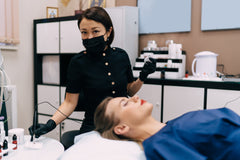📦 Free Shipping for orders of $300 or more. USPS Priority Mail Express days only applies when ordered before 1:00 pm California time. 🔷 Become a BC Member and receive free shipping on all orders no minimums! Free shipping is only offered to USA and Puerto Rico orders. Learn More >> 🔷
📦 Free Shipping for orders of $300 or more. USPS Priority Mail Express days only applies when ordered before 1:00 pm California time. 🔷 Become a BC Member and receive free shipping on all orders no minimums! Free shipping is only offered to USA and Puerto Rico orders. Learn More >> 🔷
Top 5 Mistakes to Avoid in Eyebrow Microblading...

Top 5 Mistakes to Avoid in Eyebrow Microblading and How to Fix Them
- Media BC
- -
- Sep, 06 , 24
Microblading is a precise art form that requires skill, patience, and attention to detail. As beauty professionals, delivering high-quality results not only satisfies your clients but also builds your reputation. However, even the most experienced artists can encounter challenges. This guide will outline the top 5 common mistakes in eyebrow microblading, along with professional tips on how to correct them and improve your technique.
1. Incorrect Pigment Color

Problem: Incorrect pigment selection can lead to brows that are too dark, too light, or develop undesirable tones like blue, red, or gray after healing. This often results from not fully understanding the client’s skin undertones or choosing pigments that don’t blend well over time.
Solution:
• Color Theory Mastery: Invest in advanced training on PMU color theory. Understanding how pigments interact with different skin tones is crucial for achieving the desired results. Courses that cover the nuances of warm, cool, and neutral undertones can greatly enhance your ability to choose the right pigments
• Color Correction Techniques: If a color mistake occurs, use correction techniques such as layering neutralizing pigments to adjust the existing color. For severe cases, consider removal options like saline or laser before re-application .
Prevention:
• Always perform a thorough consultation to assess the client’s skin undertones and history of pigment retention.
• Use high-quality pigments from reputable brands that offer consistency and stability over time.
2. Asymmetrical Brows

Problem: Achieving perfect symmetry can be challenging, especially if the initial mapping is off or if there’s uneven healing between the two brows.
Solution:
• Precision Mapping Tools: Use professional tools such as the BB Compass or Golden Ratio Divider to ensure symmetry from the start. Consistent measurements are key to preventing asymmetry .
• Adjust Through Touch-ups: If asymmetry is noticed after healing, a skilled touch-up session can correct the shape by adding or adjusting strokes. Address asymmetries early to avoid compounding the issue.
Prevention:
• Double-check measurements from multiple angles and ensure that clients keep their mimic muscles as still as possible during the brow mapping process.
• Educate clients on proper aftercare to support even healing on both brows.
3. Blurred or Merged Strokes

Problem: Over time, especially on oily skin types, crisp microblading strokes can blur or merge, resulting in a less defined, powdery appearance.
Solution:
• Technique Adjustment: Adjust your technique based on the client’s skin type. For oily skin, consider using techniques like powder brows or ombré shading, which can offer better results and longevity .
• Partial Removals and Corrections: For blurred strokes, consider partial removals through saline, glycolic acid or laser methods before reintroducing new strokes or shading techniques.
Prevention:
• Perform a detailed skin assessment before the procedure and choose the microblading technique that best suits the client’s skin type
(Note: If your client has excessively oily skin they are not candidates for microblading.)
• Educate clients on avoiding excessive sweating, makeup, or harsh skincare products on the brows during the healing process.
4. Improper Depth of Pigment Implantation

Problem: The depth at which pigment is implanted significantly impacts the outcome. Too shallow, and the pigment will not retain well; too deep, and it may cause scarring, uneven color distribution or inaccurate tone appearance.
Solution:
• Practice Depth Control: Regularly practice on artificial skins and models to perfect your depth control. Aim to place the pigment within the upper dermis without reaching the deeper layers, which can cause scarring.
• Adjust Techniques for Skin Types: Different skin types require different depths. Oily skin may require slightly deeper strokes due to its larger pores and thicker epidermis, which help retain the pigment better. In contrast, dry or sensitive skin benefits from a gentler touch to avoid over-penetration and potential scarring.
Prevention:
• Use high-quality tools with adjustable needles that allow for precision in depth control.
• Continuously refine your skills through advanced courses focused on technique and equipment handling.
5. Unrealistic Shape or Style

Problem: Creating brow shapes that are too dramatic or unnatural can result in brows that don’t suit the client’s face, leading to dissatisfaction.
Solution:
• Detailed Mapping and Client Consultation: Always start with a detailed mapping process and involve the client in deciding the best shape that complements their facial structure. Using tools like digital brow mapping can help visualize the outcome before the procedure begins .
• Corrective Shaping: For clients who already have botched shapes, encourage natural brow growth and make gradual adjustments through multiple sessions to achieve the desired look.
Prevention:
• Focus on enhancing the client’s natural brow shape rather than completely altering it. Aim for subtle changes that enhance rather than overpower the face.
• Set realistic expectations during the consultation and provide examples of natural, flattering brow shapes that suit the client’s unique features.
Conclusion

Avoiding these common microblading mistakes is essential for achieving client satisfaction and maintaining your professional reputation. By investing in ongoing education, mastering your technique, and prioritizing clear communication with your clients, you can minimize errors and deliver consistently beautiful results. Remember, prevention is always better than correction, so take the time to get it right from the start.
For more professional tips and advanced training in microblading, explore our courses designed to enhance your skills and confidence as a beauty artist. Book a consultation or training session with us today to elevate your craft.
← Older Post Newer Post →
Search
Recent Post
The Perfect Balan...
Dec 08, 2025From Studio to Pe...
Nov 12, 2025Color Correction ...
Oct 15, 2025Archive
- September 2025
- April 2025
Tags
Custom Menu
Added to cart successfully!
FROM_JS
Compare Product
Countdown message




